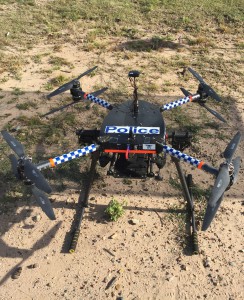
The use of drones by authorities has increased around the globe. In the US, drones have been used not only for police surveillance and in operations, but also to patrol its southern borders. Police forces in the UK, <a
href=”http://www.thepressproject.net/article/64356/Is-Greece-to-lead-the-way-for-Europe-in-the-use-of-drones-for-domestic-policing-and-surveillance”>Greece and other European countries are using drones in similar ways, as is Australia.
There is a consistency in the stated rationale for this use: drones are an effective way of gathering intelligence in situations that are unsafe for officers or impractical for helicopters. In Australia, for instance, drones have been touted for use in bushfire situations, for search-and-rescue missions and for gathering intelligence in drug-related crimes.
There is nervousness about privacy issues related to surveillance by drones and the ways that authorities may ultimately use any information gathered. UAV use for border control has also created concerns around diplomatic relations.
Mission creep by remote control
Drone technology creates a high potential for “mission creep”. Like many weapons in today’s police arsenal, UAVs were initially designed for military use. Drones have been used in armed conflict in Palestine, Pakistan and Syria.
Although these military drones are equipped with lethal weaponry and are much larger than the drones that police forces use, all UAVs are operated remotely via a laptop with a game-like console. This is part of their appeal: personnel can unleash lethal force without exposure to counterforce.
In the late 1990s and early 2000s, police approaches to crowd control changed in the US, Australia and in Europe. “Negotiated management” strategies, which involved a consultative approach to crowds and a high tolerance for minor infractions such as swearing, gave way to a “command and control” approach. This was characterised by zero tolerance for misdemeanours and the aggressive control or physical proscription of public areas for the purposes of peaceful protest.
Such policing reflected the ideology that all crowds were mobs just waiting to happen. Policing at the APEC summit in Sydney in 2007, the G20 in London in 2009 and recently during Hong Kong’s Umbrella Revolution are paradigmatic of command and control approaches. It has become commonplace for protesters to be encircled and outnumbered by police.
Indian and South African authorities have embraced the technology for use in crowd situations, including protests. Officials described the equipment as a very effective form of “mob control”, which enables the dispersion of “violent protesters”.
Weaponised drones: is Australia next?
What, then, do these uses and the US move to equip drones with less-than-lethal weaponry mean for crowd control in Australia? It’s hard to say.
In Australia, criticism of over-the-top approaches to crowd control has led to their softening, but their effect lingers. New South Wales police acquired a A$700,000 water cannon, which was sent to Queensland for the 2014 G20 meeting in Brisbane. The use of capsicum spray is now increasingly common. In Victoria, police now have the power to disperse peaceful protesters if they suspect a crowd may become unruly.
There are already concerns in Australia about the rate of escalation of force at some protests and about the use of less-than-lethal weaponry itself.
Although touted as an alternative to lethal force, research indicates that less-than-lethal weapons are being used in addition to lethal force, often in situations to force compliance. Concerns about police training and transparency in the use of less-than-lethal weapons have also been raised.
Although it is unlikely Australian police will adopt drones for crowd control particularly soon, it cannot be ruled out. Perhaps debates about privacy, data retention and encroaching enforcement powers – such as those announced for the abruptly cancelled Operation Fortitude – should extend to UAVs and other technologies that are developing more quickly.